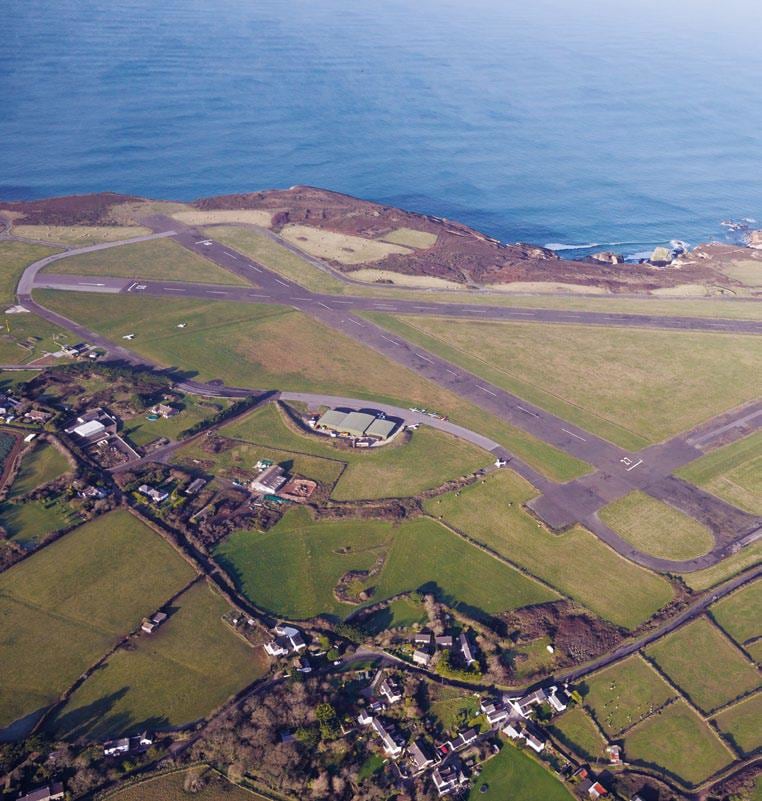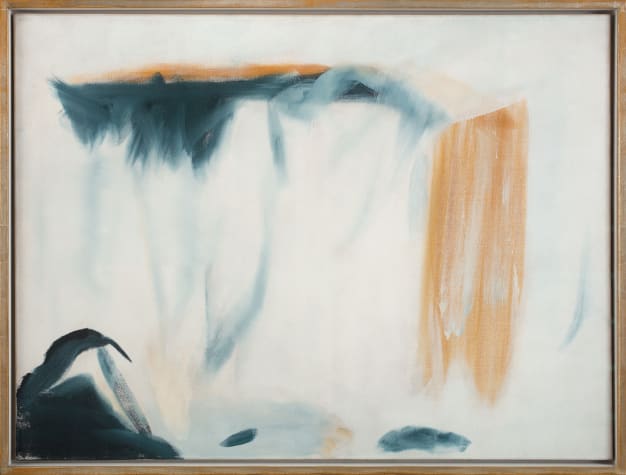Surveying the sea, coast and sky from the cockpit of a glider, Peter Lanyon experienced the Cornish landscape in a state of heightened awareness.
InSight No. 158
Peter Lanyon, Still Air, 1961
High above the ground, somewhere between 5,000 and 10,000 feet, the lower troposphere is heaving with activity. The artist Peter Lanyon (1918–1964) compared it to hydrography and the ceaseless rise and fall of the oceans: ‘The air is a very definite world of activity as complex and demanding as the sea’. Warm air rises; cold, heavy air falls. Driven by the rising and falling temperature of the earth below, these elementary processes create changes in atmospheric pressure which in turn affect the weather. After Lanyon took up gliding as a hobby in 1959, the movements and behaviour of air as experienced during flight quickly became an important theme of his paintings.

Unlike some other British painters who developed personal idioms of painterly abstraction in the fifties and sixties, Lanyon required his paintings to communicate information about a definite subject. As he wrote in 1962, ‘I do not begin a painting until I know what I want.’ Whereas Alan Davie and Patrick Heron, for example, made paintings that pertained to the act of painting itself and formal relationships internal to a given artwork, Lanyon originated a kind of non-imitative representation peculiar to himself. The transient quality of his subject provided the inspiration for a group of work, the titles of which are a key to their interpretation: Backing Wind, Rising Air, Inshore Wind, and so on. Known collectively as the gliding paintings, mostly executed between 1960 and 1964, they succeeded his ‘weather paintings’ and created a new region of art in which painterly forms sought to evoke the interaction between a glider and the conditions that affect its flight.
Lanyon occasionally used surprisingly literal ways to describe these paintings. Although he also sought to evoke ‘the places where solids and fluids meet’, he regarded certain paintings as records of a specific glidepath and the quality of experience—variously tranquil or turbulent—when taking it. In Solo Flight, ‘[t]he red is the track of something moving over the surface of the painting, and, at the same time, the track of the aircraft moving over the ground below. Blue air merges with the ground.’ The layers of a painting often correlated to a literal spatial relationship (above and below), even as that notation was used simultaneously with other devices—the elemental division of land and sea, the directional quality of lines (diagonals especially indicated lift-off).
In aeronautics, the phrase ‘still air’ means there is no wind and no vertical air motion. Lanyon’s painting of that title is uniquely tranquil amongst the gliding paintings, and a mist-like skin of white paint variously overlays and entwines wet-on-wet with contrastingly vibrant channels and islands of muted orange and navy blue. The surface and underlayers were both painted thinly, such that subtle variations of colour in the underlayer are vividly apparent at the surface. Lanyon often worked on such paintings during intense bursts of activity, and the range of his painterly idiom is well represented by Still Air and Airscape, both of which—as indicated by the artist’s inscriptions to the reverse of each canvas—were completed in September 1961. Lanyon also used significant quantities of undiluted white paint in Airscape, but here the paint quality is tangibly thicker and the handling more gestural. Crisp sweeps of a loaded brush and wet-on-wet passages suggest a frothing, dynamic system of activity in contrast to the static one in Still Air. Such a range of invention was suggested to Lanyon by land and sky, and the idiom he devised was knowingly responsive to changes in the weather.

There is nothing uniquely English about a pictorial interest in atmospheric conditions. Wedged at the frontier between competing weather systems, the situation of the British Isles has provided rich material for a range of artists as the Courtauld Gallery’s present exhibition illustrates. Claude Monet’s visits to fin-de-siècle London, its skies congested by constellations of fog and pollution, resulted in a place-specific art that was altogether absent of nativism. Lanyon chose to project his local identity, and during his lifetime the brief biography printed in his exhibition catalogues sometimes began: ‘Peter Lanyon is a Cornishman’. Yet his art benefitted from exposure to crosscurrents of artistic activity that spanned the Atlantic. Much like Monet, his success lay in discovering ingenious painterly mechanisms in the face of complex, ethereal subject-matter. As Lanyon said, reflecting on the desperate nature of this activity, ‘[w]ithout this urgency of the cliff-face or of the air which I meet alone, I am impotent.’

Images:
Perranporth Airfield, Cornwall
Claude Monet, Charing Cross Bridge: Fog on the Thames, 1903, Harvard Art Museums, Cambridge, USA
Peter Lanyon, Still Air, 1961, oil on canvas, 91.1 x 122 cm


